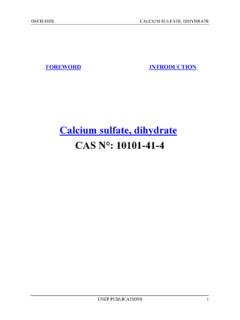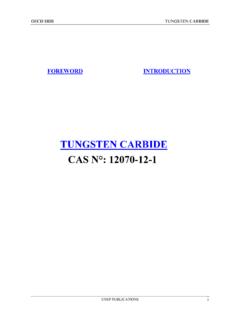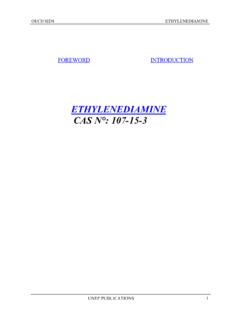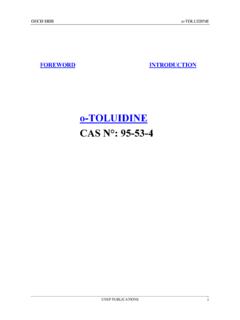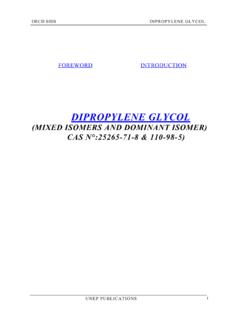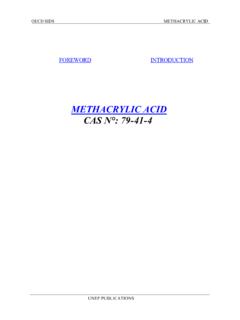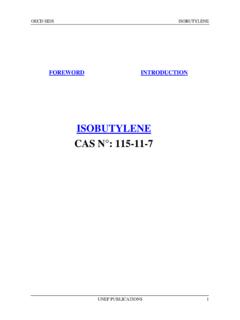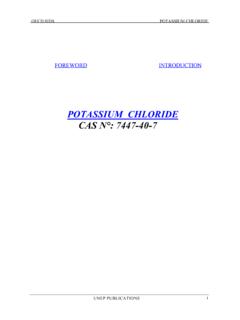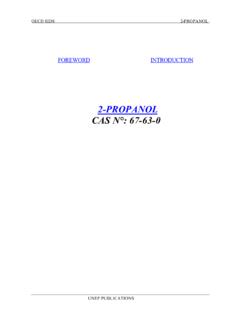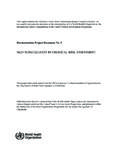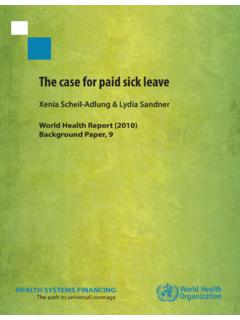Transcription of ETHYLTRIACETOXYSILANE CAS N°: 17689-77-9
1 OECD SIDS ETHYLTRIACETOXYSILANE UNEP PUBLICATIONS 1 FOREWORD INTRODUCTION ETHYLTRIACETOXYSILANE CAS N : 17689-77-9 OECD SIDS ETHYLTRIACETOXYSILANE UNEP PUBLICATIONS 2 SIDS Initial Assessment Report For SIAM 21 Washington, DC, 18-21 October 2005 1. Chemical Name: ETHYLTRIACETOXYSILANE 2.
2 CAS Number: 17689-77-9 3. Sponsor Country: United States Oscar Hernandez Director, Risk Assessment Division (7403M) Environmental Protection Agency 1200 Pennsylvania Ave, Washington, DC 20460 Phone: 202-564-7641 4. Shared Partnership with: Silicones Environmental Health and Safety Council (SEHSC): Clariant LSM (Florida), Inc. Degussa Corporation Dow Corning Corporation GE Silicones Rhodia Inc. Shin-Etsu Silicones of America Wacker Silicones, A Division of Wacker Chemical Corporation 5. Roles/Responsibilities of the Partners: Name of industry sponsor /consortium Silicones Environmental Health and Safety Council Contact point: Tracy Hill SEHSC 703-904-4322 Process used The SEHSC produced the documents; EPA reviewed the documents and provided additional information where there were data gaps. 6. Sponsorship History How was the chemical or category brought into the SIDS Program? Documents were prepared and reviewed by industry prior to submission to sponsor country.
3 Sponsor country conducted reviews of submitted data and offered comments to industry. Industry prepared and resubmitted documents for consideration at SIAM 21. no testing ( X ) OECD SIDS ETHYLTRIACETOXYSILANE UNEP PUBLICATIONS 3testing ( ) 7. Review Process Prior to the SIAM: The EPA reviewed this case. 8. Quality check process: Literature searches were conducted by sponsor country to determine if all relevant data have been included in this submission. 9. Date of Submission: December 2004 10. Comments: 1. Acetic acid is currently sponsored by the Czech Republic. 2. Acetic acid and its salts were sponsored by the American Chemistry Council Acetic Acid and Salts Panel under the USEPA HPV Challenge Program. 3. Data from the structural analogue, vinyltriacetoxysilane, is considered to be representative of acetic acid, due to the rapid hydrolysis rate of this material.
4 OECD SIDS ETHYLTRIACETOXYSILANE UNEP PUBLICATIONS 4 SIDS INITIAL ASSESSMENT PROFILE CAS No. 17689-77-9 Chemical Name ETHYLTRIACETOXYSILANE Structural Formula CH3 OOH3 COOCH3 OOSiH2 CCH3 SUMMARY CONCLUSIONS OF THE SIAR Analogue Justification ETHYLTRIACETOXYSILANE undergoes rapid hydrolysis in moist/aqueous environments (t1/2 is less than 13 seconds) to acetic acid and the corresponding trisilanol, thus observed toxicity is likely due primarily to acetic acid. Abiotic hydrolysis products of the test substance undergo continuous condensation reactions to produce higher molecular weight cyclic and linear siloxanes (the number-average and weight-average molecular weights were 633 and 809 with 22 area % of the chromatogram higher than 1000 molecular weight at the1-hr reaction time; at the 4-hr reaction time, the number-average and weight-average molecular weights increased to 750 and 1085 with 38 area % of the chromatogram higher than 1000 molecular weight, respectively).
5 The alkyl silanols condense to siloxane oligomers; this condensation of silanols is affected by both concentration and pH, and since both change over time it is not feasible to isolate specific silanols for analysis. While the hydrolysis of ETHYLTRIACETOXYSILANE is rapid, the polymerization products, while not volatile, are in a molecular weight range small enough to be considered, at least in part, biologically available. The structural analogue methyltriacetoxysilane (CAS number 4253-34-3) has been used for in vitro bacterial gene mutation and chromosomal aberrations endpoints. The hydrolysis product, acetic acid (CAS number 64-19-7) and its salts [calcium acetate (CAS number 62-54-4), potassium acetate (CAS number 127-08-2) and sodium acetate (CAS number 127-09-3)]), have been used to assess the acute aquatic toxicity (fish, aquatic invertebrate and algae), repeated dose toxicity, fertility and developmental toxicity endpoints.
6 Acetic acid and its salts are grouped together because of their close structural relationships and the salts are the neutralized form of the acid that can be more easily administered, their natural occurrence in plants and animals, and their fundamental role in cell metabolism, particularly in the tricarboxylic acid cycle (also known as the citric acid or Kreb s cycle), which is where humans get their energy. In addition the structural analogue vinyltriacetoxysilane (CAS number 4130-08-9) has been used to support the acute aquatic toxicity endpoints. Data from both ETHYLTRIACETOXYSILANE and vinyltriacetoxysilane are representative of acetic acid, based on the rapid hydrolysis of these materials. Human Health The acute toxicity of ETHYLTRIACETOXYSILANE is described by an LD50 rat (oral) = 1462 mg/kg. Clinical signs included decreased activity; lethargy; lacrimation; salivation; irregular gait; hunched posture; decreased body weight, food consumption and fecal volume; red urine; red staining of the snout, eyes and extremities; and labored respiration.
7 Although acute toxicity data for the inhalation or dermal routes of exposure are not available for ETHYLTRIACETOXYSILANE , these exposures will likely result in local site of contact effects from acetic acid. ETHYLTRIACETOXYSILANE is severely irritating and corrosive to the skin, is expected to be severely irritating to the eyes of animals, and is likely to be a respiratory irritant based on production of acetic acid following hydrolysis. In a 7-day oral range-finding study (gavage) rats were treated with undiluted ETHYLTRIACETOXYSILANE (dose levels of OECD SIDS ETHYLTRIACETOXYSILANE UNEP PUBLICATIONS 50, 17 (males), 23 (females), 100, 500 and 1000 mg/kg/d). ETHYLTRIACETOXYSILANE rapidly hydrolyzes (in seconds) to acetic acid and a trisilanol (3:1).
8 The silanol generated is insignificant in both quantity and toxicity relative to the production of acetic acid and its associated toxicity. Animals from the 17 (males), 23 (females) and 100 mg/kg/day dose groups survived to day 7. Animals from the 500 and 1000 mg/kg/day dose groups were sacrificed after the third dose as a consequence of two deaths (one from each group), marked body weight loss, and severity of lesions (ulceration and erosion of stomach and esophagus) observed in necropsied animals. The stomach lesions observed resembled irritation from acetic acid production. This 7-day range-finder study indicated that a maximum dose level of less than 20 mg/kg/day would be required for a longer duration repeated dose study in order to avoid death or obvious suffering due to the corrosivity of the hydrolysis product, acetic acid. Based on the findings of the 7-day range-finder, a longer duration study will present technical difficulty questioning dosing accuracy and a very low nominal systemic dose.
9 Additional testing (repeated dose, reproductive effects or developmental toxicity) with ETHYLTRIACETOXYSILANE has not been conducted. Toxicity is represented by an irritative mechanism following single or repeated dosing, likely due to production of acetic acid during hydrolysis. NOAELs following repeated exposure to acetic acid and its salts range from 210 mg/kg bw/day (2-4 month acetic acid drinking water study; systemic toxicity) to 3600 mg/kg bw/day (acetic acid, sodium salt, 4 week dietary study; no effects reported). Signs of irritation/corrosion at the site of contact as well as systemic toxicity have been reported. Prolonged inhalation exposure to acetic acid results in muscle imbalance, increase in blood cholinesterase activity, decreases in albumins and decreased growth at concentrations greater than mg/m3/day. Groups of 20 mice/sex were given sodium acetate in the drinking water (about 60 mg/kg bw/day) for 1 week before breeding, during a 9-day breeding period and (females only) throughout pregnancy, lactation and until the offspring were weaned at 3 weeks of age.
10 The male offspring were given the same solution until they were 5-7 weeks old and were then examined in a 24-hour activity test. No effects on fertility were observed. Examination of the litters revealed no overt deformities, and pup weights were normal at day 1 and day 21. The activity of offspring of the treated group was lower than that of controls during the first 12 hours but was similar during the second 12 hours. It is unknown if the decreased activity observed in the sodium acetate treated group to was a result of exposure in utero and/or post-weaning, since the pups were exposed during both time periods. Acetic acid had no effects on implantation or on maternal or fetal survival in rats, mice or rabbits dosed via gavage on days 6-19 to doses up to 1600 mg/kg/day. The number of abnormalities seen in either soft or skeletal tissues of the test groups did not differ from the number occurring in the controls. Sodium acetate had no effect on parents or offspring when mice were administered 1000 mg/kg bw, by gavage on days 8-12 of gestation.
